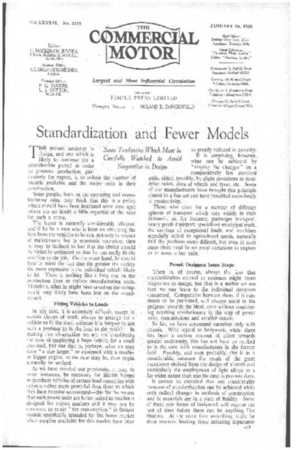Standardization and Fewer Models
Page 21

Page 22

If you've noticed an error in this article please click here to report it so we can fix it.
THE present tendency in design, and one which is likely to continue for a considerable period in order to promote production, Particularly for export, is to reduee the number of models available and the major units in their construction.
Some people, bath on the operating and manufacturing sides, may think that this is a policy which should have been instituted some time ago; others are no doubt a little regretful of the need for such a move.
The buyer is naturally considerably affected, and if he be a man who is keen on obtaining the best from the vehicles to be run, not only in respect of maintenance but in economic operation, then he may be inclined to feel that the choice should be virtually unlimited so that he can really fit the machine to the job. On the other hand, he should bear in mind the fact that the greater the variety the more expensive is the individual vehicle likely to be. There is nothing like a long run on the production lines to reduce manufacturing costs.. Therefore, what he might have saved;on the swings. would vory likely have been lost on the round abouts.
Fitting Vehicles to Loads In any case, it is extremely difficult, except, in certain classes of work, always to arrange for a" vehicle to fit the load whereas if is frequently not such a problem to fit the load to the .vehiele. In making this observation wo are not considering the case of 'employing a huge vehicle for a sthall pay-lbad, bur one that is, perhaps, what we may, term "a size larger," or equipped with a smaller, or bigger engine, as the case may be, than might normally be utilized.
As we have pointed out previously, it may, in ,ome instances, be necessary for British buyers to purchase vehicles of certain load capacities with engines rather more powerful than those to which they have become accustomed—this for the reason that such power units are better suited to machines designed for export markets and it may not be economic to retain "for consumption" in Britain models specifically intended for the home market when supplies available for this market have been Some Tendencies Which Must be so greatly reduced in quantity. It is surprising, however, Carefully Watched to Avoid what can be achieved by Stagnation in Design "ringing the changes" on a comparatively few standard units, aided, possibly, by slight deviations in finaldrive ratios, sizes of wheels and tyres, etc. Some of our Manufacturers have brought this principle almost to a fine art and have benefited accordingly in productivity.
Those who cater for a number of different spheres' of transport which vary widely in their demands, as, for instance, passenger transport, heavy goods transport, specialized municipal work, the carriage of exceptional loads, and machines especially suited to agricultural needs, naturally find the problem more difficult, but even in such cases there need be no great variations in engines or in some other units.
Permit Designers Some Scope There 'is, of course, always the tear that standardization carried to extremes might mean stagnation in-design, but that is a matter we are sure we can leave to the individual designers concerned. Competition between them, if it continues to be permitted, will always assist in the progress towards the ideal, even without considering anything revolutionary in the 'way of power units, transinissionS and smalleedetails.
. So far; we have concerned ourselves only with chassis, With regard to bodywork, whilst there has been a certain amount of effort towards greater uniformity, this has not been so marked as.is the,. case with manufacturers in the former geld. Possibly, and even probably, this is in a considerable, :measure the result of the great experience derived from the design of aircraft and particularly the employment of light alloys to a far wider extent than was the case in pre-war days. It cannbt be expected that any considerable measure of standardization can be achieved while such radical changes in methods of construction and in materials are in a state of ffitidity. Some of these new forms of bodywork will require 'the test of time before there can be anything like fixation. At the same time something might be done towards limiting those irritating departures Al9 from standard which are called for oy the individual tastes of some operators. Small deviations frequently cost bodybuilders a great deal of trouble and involve much waste of time, and it would seem highly advantageous that they and such operators should get together and lay their cards on the table. We are sure that quite often a solution satisfactory to both parties could be discovered. Even in comparatively unimportant although essential fittings, particularly on buses, there may be a dozen or so variations in design and dimensions which. call for the same number of additional jigs; this apart from the difficulties involved in cluttering up stores and shops with the parts required and in maintaining stocks of spares for subsequent use—possibly for a considerable number of years.












































































